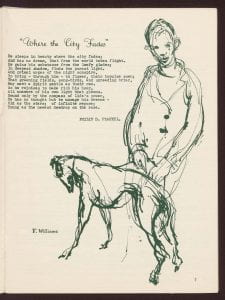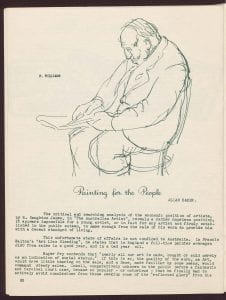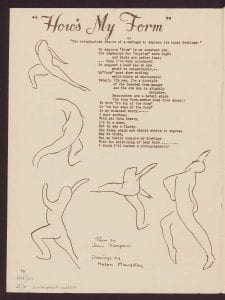The beginnings of a brilliant career
Catherine Nunn
Daub is a student art magazine which records the first steps in the artistic careers of some of Australia’s most important artists. Several articles reflect the challenges of life at the School and the torment of the creative process, but they also record the self-awareness of these young artists about their place in the Western art lineage and their commitment to progressing contemporary art[1].

Amidst the more grand proclamations, the practical requirements of art making is also a concern. Lucy Kerley’s article ‘Preparation of Painting Ground’ (Daub 1948, pages 12-13) describes how to prepare a canvas for painting with helpful diagrams of the stretching process (figure 1). If this had to be explained in the magazine, one wonders if there was a lack of instruction in basic artistic methods at the time?
Materially, the construction of the 1947 edition is also intriguing. Produced by the ‘night students’ and printed in Brunswick (dark) green ink on a thick, creamy textured paper, the volume is stapled at the spine. The archived edition has a printing error so that pages start at 10, and run back to 4, and jumbled and repeated pages continue through the edition. Is this hasty compilation by students juggling their day-time work and family commitments with an evening dedication to their art studies? Is the copy held by University Archives the only evidence of this error or mishap, or was the entire circulation flawed?


But let us return to the contents and the question of who appears in Daub. Names from 20th Century Australian art history feature – John Brack[2] and Helen Maudsley (who were later married) and early drawings by Fred Williams (figure 2 and 3).
Williams’s drawings appear to have been made ‘from life’, as was customary for students of the school, and the lyricism of Helen Maudsley’s drawings illustrating a poem suggest that she was watching a dance performance while sketching, signifying an aesthetic entanglement with the various art forms of poetry, drawing and movement, that were experienced by students at the School (figure 4).

The magazine also tells the stories of young teenage students (Fred Williams was only 16 when he enrolled)[3] as well as mature age ‘night students’ with families. While some of the articles refer to conflicts within the school, the personal column ‘Wot! No skandle?’ evokes the collegial supportiveness of students for each other. In these columns, there are congratulations for weddings, births, engagements, and the exciting news in 1949 that the National Gallery (NGV) had purchased a drawing by Fred Williams aged then 22 (Daub 1949 page 12)! This work on paper is (Figure of a boy) now in the NGV collection. Today, Williams is recognised as one of Australia’s greatest painters and his works feature in all major Australian gallery collections as well as internationally at Tate. As history however reveals, going to the National Gallery School of Art was the beginning of a brilliant art career and Daub is one of the documents that help us to understand how one generation started with humble beginnings, shared experiences and personal ties.
Catherine Nunn is a PhD Student with the Grimwade Centre for Cultural Materials Conservation currently researching the materials and techniques of the Australian Impressionists.
References:
Grishin, S 1990, The Art of John Brack, Oxford University Press, Melbourne
Macnaughtan, J 2004, From life: works by early generations of students at the National Gallery Art School, Victorian College of the Arts, Southbank
McCaughey, P 2008, Fred Williams 1927-1982, Murdock Books, NSW
University of Melbourne Archives
2007.0060.00150 ‘Daub 1947’ Lucy Kerley/National Gallery School
2007.0060.00151 ‘Daub 1948’ Lucy Kerley/National Gallery School
2007.0060.00152 ‘Daub 1949’ Lucy Kerley/National Gallery School
[1] ‘The Eternal Cavalcade’ is such an article on pages 23-24 of the 1947 edition.
[2] John Brack later became Head of National Gallery of Victoria Art School (1962–68) (Grishin 1990, p. 86). The 1954 edition of Daub contains a self-portrait by Brack on page 6.
[3] McCaughey 2008, p. 26.
Leave a Reply